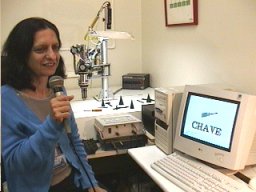

To see the Robot Arm in operation, click one of the links from the table below.
The application aims at the development of an environment which integrates several intelligent systems. Four main sub-systems work cooperatively to perform the desired task: a robust speak-independent word recognition, computer vision, robot arm trajectory planner with obstacle avoidance and a multivariable self-tuning control. The goal of this application is to allow any operator to command by voice a SCARA robot arm to pick up a specific tool placed on a table among others tools and obstacles avoiding any obstacles which may collide with its grip.
The speech recognition sub-system is word orientated and speaker independent. A Recursive Neural Network architecture is used to recognize trained and untrained words. The network is totally interconnected and a backpropagation trainining algorithm is used. The advantage of the recursive neural network is its ability to avoid the generation of "false alarms". In fact, the network seems to be able to build in more knowledge on the internal syllables of the word.
The robot arm scans its work area in a sequence of steps by performing a rotation of the robot arm shoulder. At each step the image captured by a CCD camera is analyzed. The object recognition sub-system is based on the extraction of geometric attributes from the object images. It's robust in relation of illumination conditions and the system recognizes the object and its rotation angle with one degree of precision.
A multivariable self-tuning control algorithm is responsible for making the robot arm grip precisely track the pre-defined trajectory. Self-tuning is an attractive approach for the design of robot arm controllers due to its ability to cope with the non-linearities of the robot arm dynamics. In addition, with the use of the multivariable algorithms, the interaction forces among the robot arm joints are taken into consideration and a better model of the robot arm dynamics is achieved.
During the work area scanning process, all the detected obstacles are memorized and this information is recovered at each new movement in order to planning a suitable path which the robot arm grip should follow to reach a specific goal. The trajectory to be followed by the robot arm under self-tuning control is determined using either Visibility Graphs or Potential Field techniques.
![]()